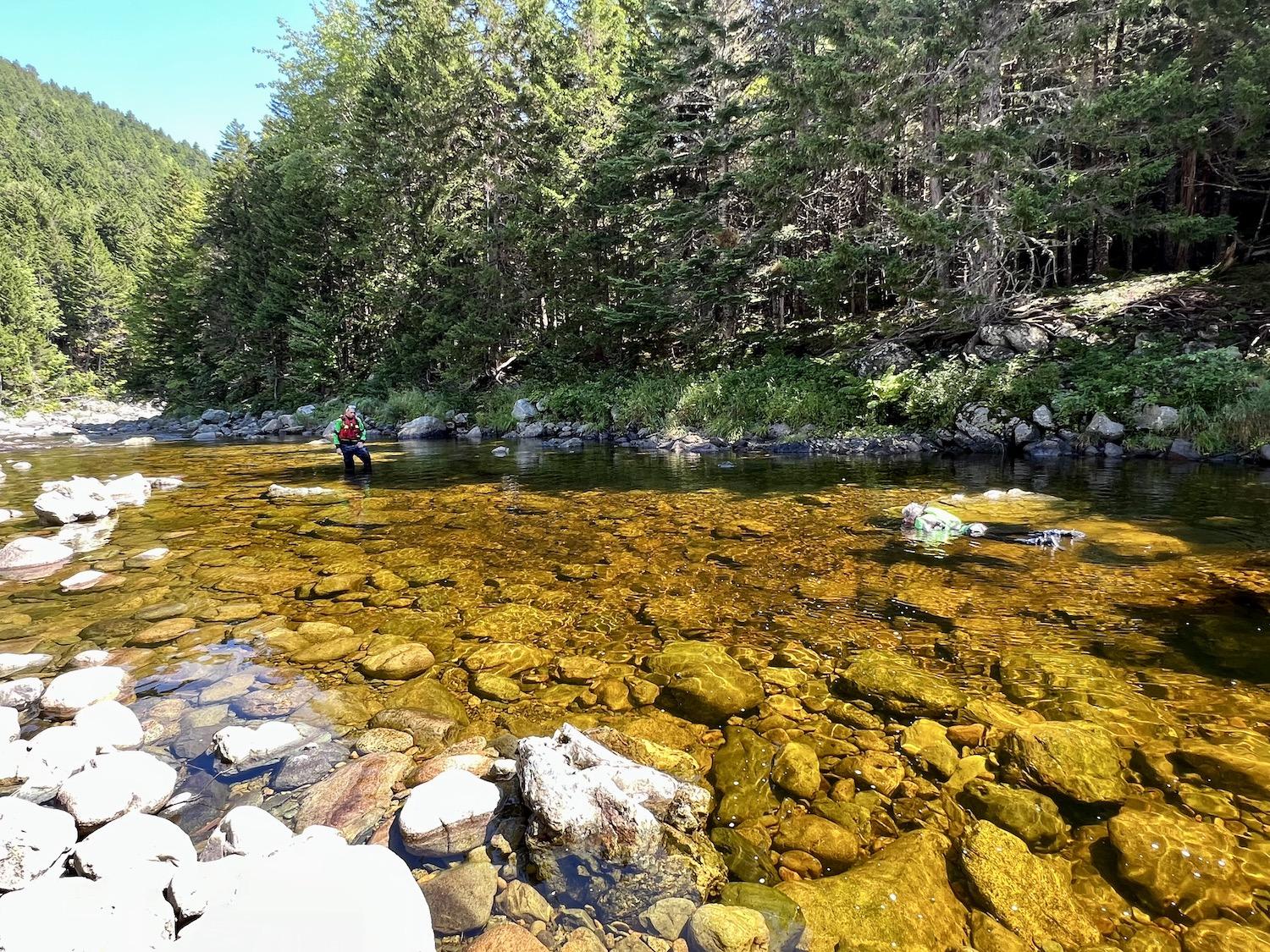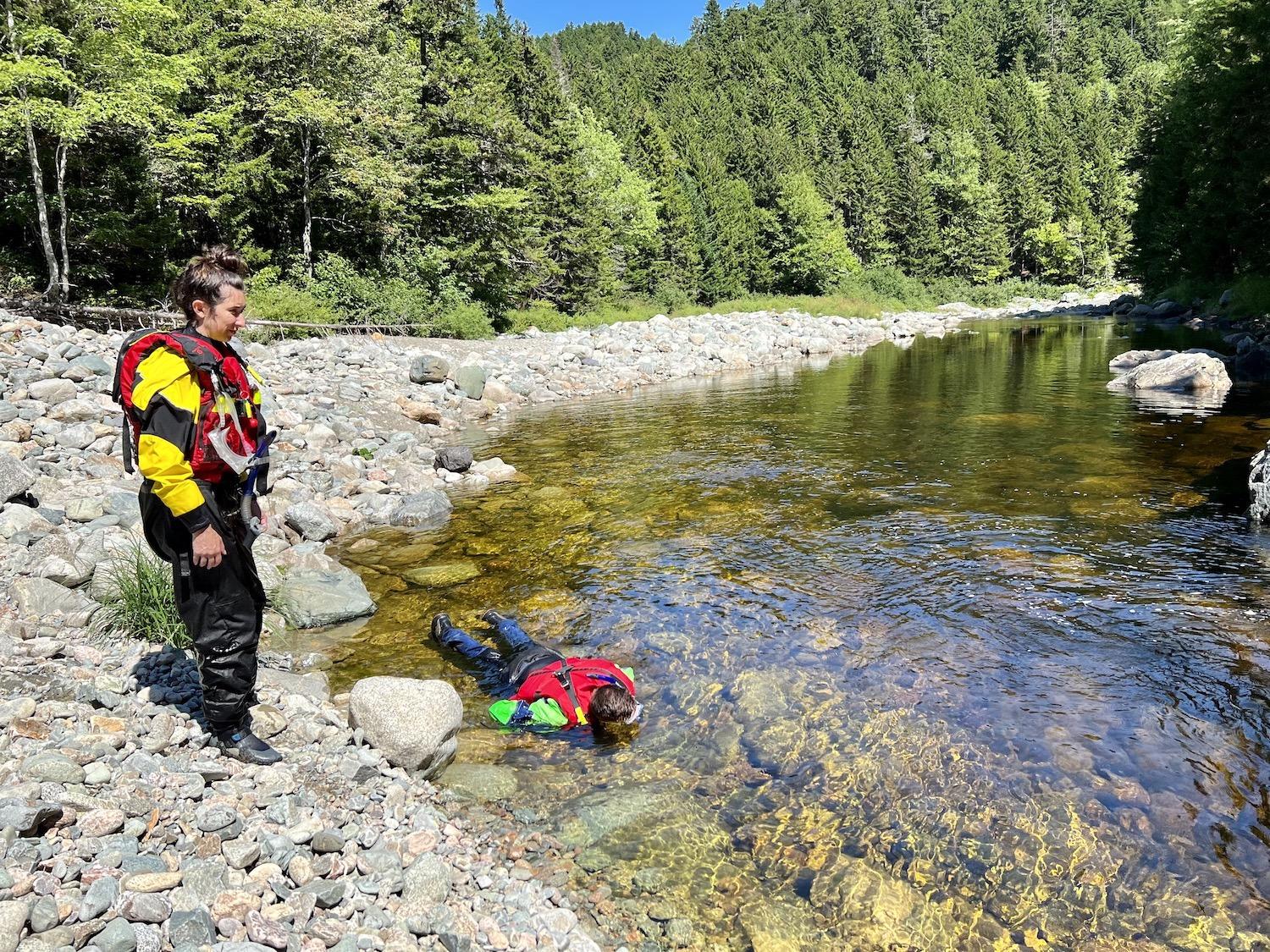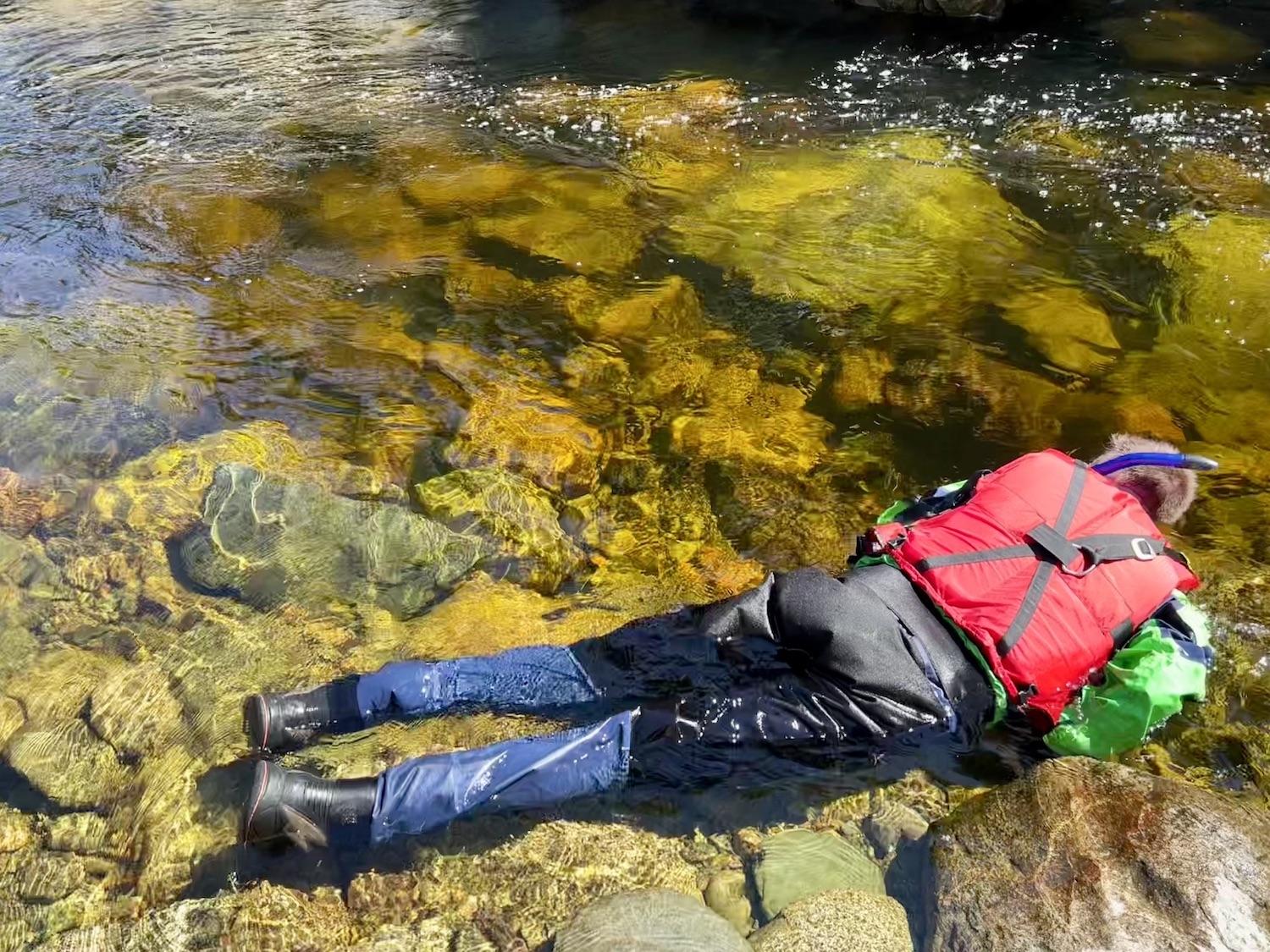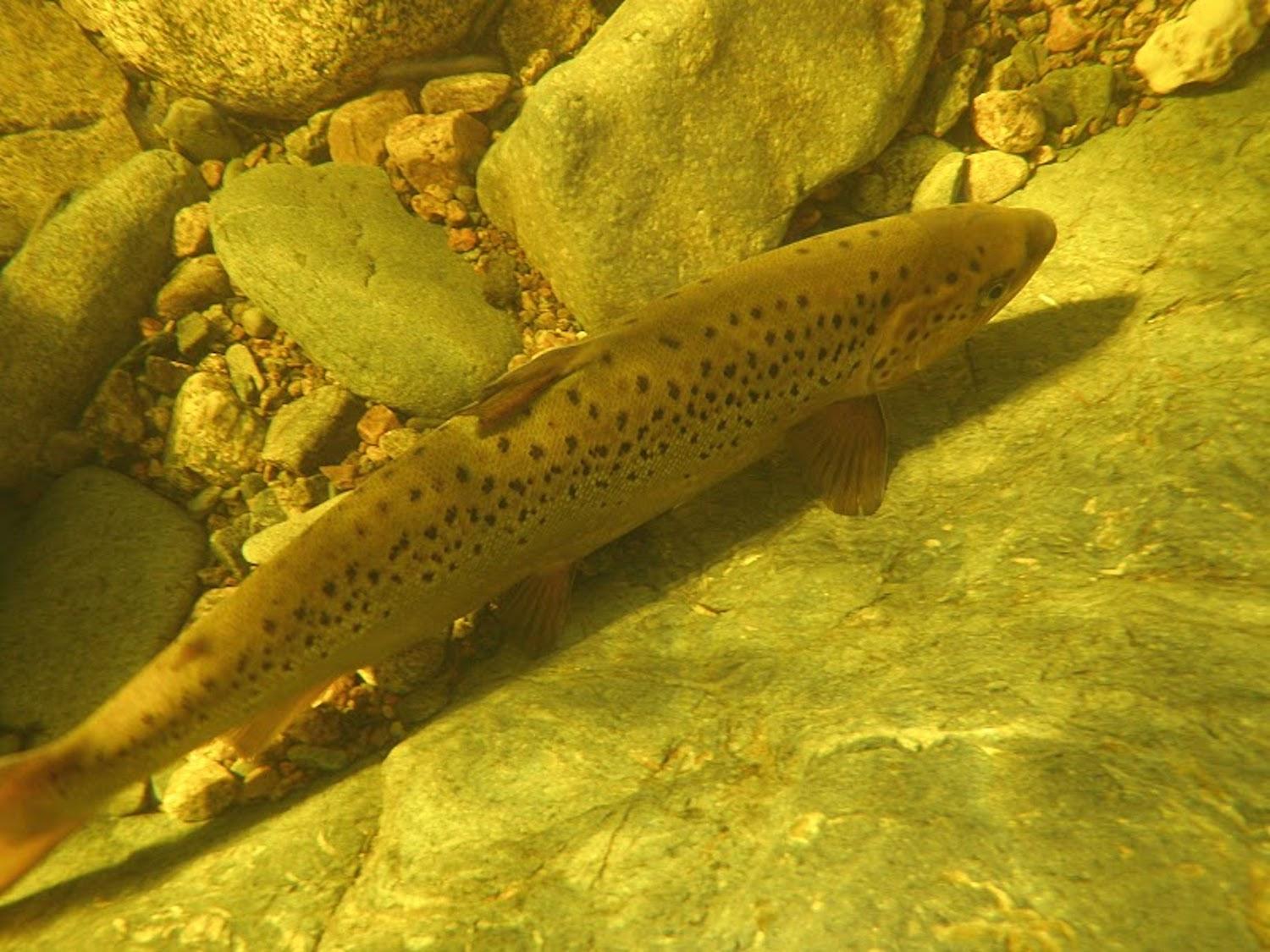
Parks Canada's John Robinson watches as writer Jennifer Bain snorkels in the Upper Salmon River in Fundy National Park looking for salmon/Parks Canada, Danielle Latendresse
Visiting Fundy’s Endangered Atlantic Salmon
By Jennifer Bain
It’s actually a good sign that the endangered Atlantic salmon eluded me as I snorkelled starfish-style through a river pool known as Black Hole in Fundy National Park.
They were there in the clear waters of the Upper Salmon River — Parks Canada’s Danielle Latendresse and John Robinson saw them. She’s the program stewardship coordinator for Atlantic salmon conservation and restoration. He’s a resource conservation technician and a graduate student being supervised by the research chair in aquatic restoration.
“All the salmon are hunkered down in the cool, little crevices, waiting for some water,” Latendresse said. “When it’s low and warm they like to stay put and conserve energy.”
I made three attempts to spot the wily fish and failed, perhaps because I can’t see far without my glasses or because my googles kept fogging up even though I diligently rubbed spit on them.
“They do have that flight instinct of when they see something bright or something coming at them then they start to kind of move off to the side. Then if you get too close, that’s when they’ll flash and disappear,” Robinson later explained. “After we went through the pool three times they were nowhere to be seen. They knew there was something there and now’s the time to get away. And yeah, those are the kind of genes we want going in that river.”

Parks Canada's Danielle Latendresse and John Robinson — shown on the Upper Salmon River — work to help endangered Atlantic salmon in Fundy National Park/Jennifer Bain
Five years ago, I came to this New Brunswick park to “Swim with the Salmon for Science” — a rare chance for the public to join people working to jump-start the wild salmon population. Parks Canada staff guided six of us through the day-long experience while a Fort Folly First Nation member shared the cultural and historical significance of salmon.
I triumphantly spotted four fish (or perhaps the same fish four times) that September day as I floated like a starfish in a leaking dry suit, my legs motionless, my hands gently steering. The current transported me the short distance from the top to the bottom of Black Hole in what I remember as swift water.
This August, with the public program on extended hiatus, I scored an abbreviated but private outing.
Inner Bay of Fundy Atlantic salmon are born in the rivers around here, live in them for a few years, head to the ocean to feed for about three years, and then finally return to their birthplace to spawn. But they have been doing a shortened ocean migration and not returning in healthy numbers and so have been listed as endangered since 2003.
There are likely less than 200 wild adults remaining in this population. But Fundy has been part of the innovative and collaborative recovery efforts of the Fundy Salmon Recovery project, which brings together government, Indigenous, academic and private industry partners.

To get to the Upper Salmon River salmon pool, we had to take this Parks Canada truck down some bumpy back roads that the public can't access/Jennifer Bain
Last year marked the highest number of surviving adult Atlantic salmon returning to their natal rivers from the marine environment in 32 years.
“Between the two rivers, it was 114 total returns,” said Robinson. He was wrapping up a month of electrofishing to assess juvenile salmon populations and see if the reproductive success of those returns has translated into more juveniles.
According to Latendresse, the recovery project is the first in the world to collect young salmon from the wild and raise them in the marine environment during the time they would naturally be at sea. This is done at the world’s first Wild Atlantic Salmon Marine Conservation Farm — run by Cooke Aquaculture and the Atlantic Canada Fish Farmers Association — several hours away on Grand Manan Island.
Once mature, these salmon are returned to the wild to spawn naturally so that Fundy’s river ecosystem productivity is being restored and filled with wild-hatched juvenile salmon.
“A wide body of research shows that salmon with more exposure to the wild early in life are more fit for later life in the wild, even resulting in improved wild fitness for the next generation of offspring,” said Latendresse.

At Black Hole, there's a Parks Canada warden cabin, now called a research cabin/Jennifer Bain
Traditional stocking, she explained, involves putting young fish in the river and hoping they grow to big fish. But research has shown “that those critical years for a salmon are actually when they’re born in the river so they have to have those early, early years to kind of think like a fish. It’s kind of like if I took my dog and put her in the middle of the forest she would never thrive. But if I put her in there when she was born, she would become a forest dog she would thrive and be like a coyote. It’s kind of the same idea.
“We want our fish to be more like coyotes than golden retrievers.”
Recent research by graduate students under the Parks Canada Research Chair lab have shown increasing trends in densities of juvenile salmon plus increased ecosystem productivity that are a direct result of restoration action from the Fundy Salmon Recovery collaboration. Fort Folly First Nation partners are leading a parallel project on the Petitcodiac River and seeing similar restoration trends.
Since the collaboration began, adult salmon have been released into Fundy to naturally spawn the next generation of salmon instead of producing them in captivity and later releasing to rivers. It's because of these spawning adults that Fundy is seeing an increasing abundance of wild juvenile salmon populations and ecosystem productivity throughout the Upper Salmon River.
Monitoring data shows that juvenile salmon were extremely low to non-existent before the recovery model was launched, but after the first adult release in fall of 2015, Fundy started to see a significant increase in naturally wild-produced juvenile salmon populations. Some areas now rival pre-decline juvenile densities.

Writer Jennifer Bain looks for fish in an Upper Salmon River pool known as Black Hole/Parks Canada, Danielle Latendresse
When I snorkelled, I got to mimic what biologists do on “swim throughs” to monitor and count the salmon as they prepare for spawning. I, too, wore a dry suit, water shoes, protective gloves and a life jacket to fend off the chilly water and jagged rocks.
This time, Fundy’s trail system map in hand, I realized we weren’t in as remote a spot as I thought.
Latendresse and Robinson picked me up at Fundy’s Headquarters Visitor Centre and drove down restricted roads to the Parks Canada research cabin by the salmon pools. Several groups of hikers strolled by on the Upper Salmon River Trail, an 8.2-kilometre (5-mile) trek — one way from headquarters.

Fundy National Park's hikers are told to report salmon sightings and poachers/Jennifer Bain
On the shores of the river, signs urge people to to report their salmon sightings and “help save our salmon” by reporting poaching and knowing that these fish are protected by the Species at Risk Act. Harming, catching or harassing them carries a fine of up to $25,000 ($18,000 USD) or a prison term of up to five years.
“As of yesterday, there were 40 fish in the Upper Salmon River,” said Robinson

John Robinson guides Jennifer Bain around a boulder while searching for salmon/Parks Canada, Danielle Latendresse
The salmon began coming up the river in late June, returning from the ocean and making their way upriver to spawn through October. Black Hole is one of the major holding pools where fish may stay for a few days or weeks before travelling further upstream.
There's a UNESCO Fundy Biospehre Reserve "Amazing Places" plaque for Black Hole saying the river features were created thousands of years ago when receding glaciers likely triggered a massive landslide and became a perfect habitat for the endangered Atlantic salmon. Another sign suggest the name Black Hole comes from the way the pool was gouged out by rolling logs during the lumbering era. It’s now filled in with gravel and was much calmer and lower than in 2017.
During the first swim, Robinson saw two fish, one with a white tag which means it came from Mactaquac Hatchery in Fredericton, and one with a purple tag from Marine Conservation Farm’s Dark Harbour. External tags serve as a quick identifier. Internal pit tags contain the salmon’s life history. A pit antenna at the mouth of the river detects tags but sometimes researchers swim with portable pit tag readers.
Mactaquac, Latendresse explains, is a special facility that allows them to keep our genetic strain of fish alive. “Because our population is so critically low that genetics are so important to keep around because if we lose it, we completely lose this whole strain of fish.”
Once fish become teenagers or get to the smolt stage of their lifecycle, Robinson’s team collects them on a smolt wheel and takes most of them to Dark Harbour.

Danielle Latendresse stays on shore as John Robinson quietly searches for salmon/Jennifer Bain
Latendresse also saw one salmon during her first swim. When they arrive from the ocean, they are usually still tinged silver to blend in with that environment. When they come back to the river, they become slightly brownish dark green to blend in with the algae and biofilm on the rocks.
On our second swim, Robinson saw one salmon at the top of the pool that came along the shore and hid under a rock. He spotted it again just after we floated by a boulder. “We were a little spaced out but kind of going side by side and I believe you were looking slightly to the right as it came back under me and then cut between us,” he said.
For the third and final round, Robinson moved near shore trying not to spook the fish.
“They evaded us that time,” he said.
“They’re doing their job, hiding from us,” said Latendresse.
“Yeah, they did a very good job,” Robinson replied.

John Robinson searches for salmon in the shallow, clear waters of the Upper Salmon River/Jennifer Bain
When the researchers do swim throughs, they do a 5-kilometre (3-mile) stretch.” That’s apparently easy here on the Upper Salmon River because you can usually walk along the shore.
“Some sections are really hard and you have to go up and around big rock boulders and so it gets difficult,” Latendresse admitted.
“But some of the most beautiful scenery you’ll ever see in the park,” said Robinson.
It takes a lot out of you, wearing dry suits that are so tight around the neck and wrist they leave you feeling breathless, and going where the current takes you. I admitted to feeling too woozy to walk back down to the river for lunch so we ate by the research cabin.
“I’ve heard from many people, as soon as you get out of the river there’s always that dizzy feeling, trying to get oriented again,” said Robinson. “Even people who do it fairly often still say they have that feeling. It just takes a bit to find centre ground again.”

An Atlantic salmon is shown underwater in Fundy National Park/Parks Canada
Come October, the team release salmon into the river, sometimes with a splashy public event and other times privately because it’s already stressful enough for the salmon, who are driven to the park and then sometimes released by helicopter into the water.
Because of the conservation success seen here so far, the salmon project has expended to Fundy's Point Wolfe River and Latendresse is coordinating a larger project looking at five national parks in Atlantic Canada where salmon are in various stages of decline. As well as Fundy, the project includes Kouchibouguac National Park in New Brunswick, Cape Breton Highlands National Park in Nova Scotia, and Gros Morne National Park and Terra Nova National Park in Newfoundland and Labrador.
As for me, the next time I visit Fundy's endangered salmon, I'd like to hike in to see them in the Upper Salmon River and watch for them from the comfort of the shore of Black Hole.

 Support Essential Coverage of Essential Places
Support Essential Coverage of Essential Places
Add comment